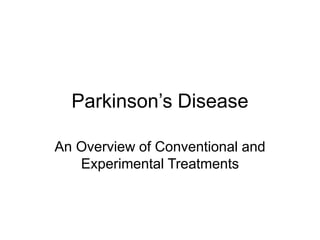
_parkinsonspresentation - Brady Miller.ppt
- 1. Parkinson’s Disease An Overview of Conventional and Experimental Treatments
- 2. Background • Parkinson’s disease is a disorder that affects nerve cells in the part of the brain controlling muscle movement • Disease is progressive – signs/symptoms worsen over time • Eventually is disabling, but progresses gradually • Believed to be caused by genetics, environmental factors or a combination of the two
- 3. Parkinson’s Disease Stats • First desribed by James Parkinson in 1817 • Affects ~1 million in the U.S. • Onset typically between 50-60 years of age, and slowly progresses with age • Average onset is 62.4 years of age
- 4. Neurological Basis • “Neurodegenerative Disease” : caused by degeneration (dysfunction and death) of neurons within the brain (nigrastriatal pathway of the basal ganglia) • NORMAL BRAIN FUNCTION – Basal Ganglia • Cells in substantia nigra produce/release dopamine • Dopamine released by SN neurons lands on neurons of other brain centers, controlling their firing • Main targets are caudate nucleus and putamen (striatum) • This basal ganglia pathway is involved in regulation of movement
- 6. Neurological Basis • PARKINSON’S BRAIN FUNCTION–Basal Ganglia • Cells of substantia nigra degenerate • These cells can no longer produce adequate amounts of dopamine • Neurons of striatum, etc. are no longer well regulated, thus do not behave in normal manner • Results in loss of control of movements – leads to symptoms characteristic of Parkinson’s disease
- 8. Characteristic Symptoms • MOTOR – tremor – bradykinesia – rigidity/freezing in place – lack of facial expression – postural instability – stooped, shuffling gait • NONMOTOR – diminished sense of smell – low voice volume – foot cramps – sleep disturbance – depression – constipation – drooling
- 10. Conventional Treatments: Medication • LEVODOPA (L-DOPA) • precursor to dopamine, converted to dopamine by nerve cells in the brain • Treatment with dopamine not possible, because dopamine can’t cross blood-brain barrier • Generally combined with carbidopa (Sinemet) – helps levodopa get to the brain + reduces some side effects • Extended use often produces dyskinesias – uncontrolled movements (writhing, twitching, shaking) among other minor side effects
- 11. Conventional Treatments: Medication • DOPAMINE AGONISTS • not changed into dopamine, but rather act LIKE dopamine at brain synapses where dopamine is usually present (nigrostriatal pathways in Parkinson’s patients) • Used both as adjuncts to L-Dopa therapy and in younger Parkinson’s disease patients • Side effects similar to levodopa, but less likely to develop involuntary movements, more likely to cause hallucinations
- 12. Conventional Treatments: Medication • MAO Inhibitors (Selegiline) • COMT Inhibitors • Anticholinergics
- 13. Conventional Treatments: Surgery • Thalamotomy • Involves destruction of small amounts of tissue in the thalamus—major center for relaying messages/transmitting sensations • Can cause slurred speech and lack of coordination • Pallidotomy • electric current used to destroy small amount of tissue in the pallidum (globus pallidus) • May improve tremors, rigidity by interrupting pathway between globus pallidus and thalamus
- 14. Conventional Treatments: Surgery • Deep Brain Stimulation • implant device, pacemaker-like unit transmits impulses to electrodes placed in subthalamic nucleus • Produces same effects of lesion surgeries, but can be turned on and off
- 15. Experimental Treatment: Surgery • Fetal Cell Transplant Therapy • stem cells obtained via aborted fetus, grown in culture, transplanted into Parkinson’s patient at nigrostriatal pathway • New cells establish connections and “replace” cells originally lost, these cells function normally and even produce dopamine • Autologous “Self” Transplant • analagous to fetal cell transplant, except that precursor nerve cells are taken from patient and coaxed to produce dopamine, then implanted back into original patient • Reduces threat of autoimmune response and reduced “controversial baggage” associated with FCT therapy
- 16. Experimental Treatment: Surgery • Retinal Pigmented Epithelial Cell Transplant • Dopamine-producing cells taken from pigmented retinal epithelium • Mechanism of transplant analagous to fetal cell transplant therapy • If loss of contact from substrate, these cells die • Consequently, lower risk of aberrant integration— possible cause of dyskinesias seen in some FCT patients
- 17. Sources • Aminoff, M. (2003). Parkinson Primer: Overview of Parkinson’s Disease. Retrieved November 16, 2005, from http://www.parkinson.org/site/pp.asp?c=9dJFJLPNB&b=71354. – This source provided me with the most of the background information necessary in explaining the foundation of the disease. This source was especially helpful in determining the characteristic symptoms of the disorder as well as statistics. • Freed, C.R., Green, P.E., Breeze, R.E., Tsai, W., DuMouchel, W., Kao, R., Dillon, S., et al. (1994). Transplantation of Embryonic Dopamine Neurons for Severe Parkinson’s Disease. New England Journal of Medicine, 344, (7), 710- 719. – This source played a large part in writing the actual paper. In this article was information on the background of stem cells, implications in stem cell research, and most beneficial, the actual experimental procedure itself. • Lieberman, A. (2004). What is Parkinson’s Disease? Retrieved November 14, 2005, from http://www.pdcaregiver.org/WhatIsParkinsons.html. – This source didn’t help much background information on the disease, but did help in providing an comprehendable version of the substantia nigra and its role in development of Parkinson’s disease. Also beneficial were the figures associated with this source.